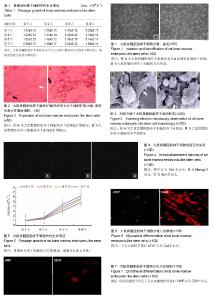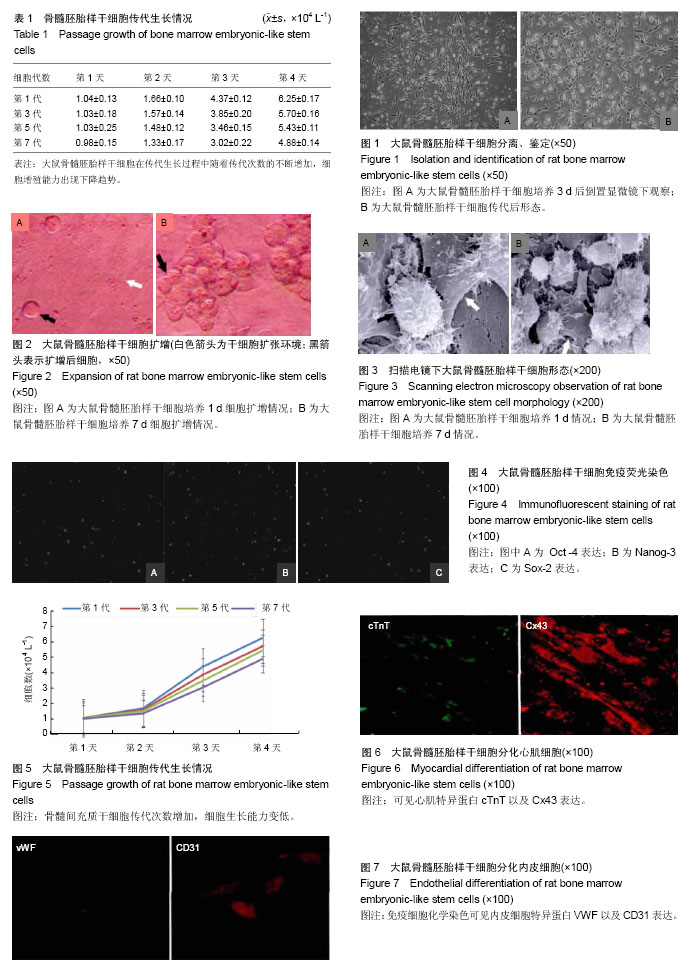| [1] Kucia M,Zuba-Surma EK,Wysoczynski M,et al.Physiological and pathological consequences of identification of very small embryonic like(VSEL)stem cells in adult bone marrow.J Physiol Phar-macal.2006;57 Suppl 5:5-18.[2] D'Ippolito G,Diabira S,Howard GA,et al.Marrow-isolated adult multilineage inducible (MIAMI) cells,a unique population of postnatal young and old human cells with extensive expansion and differentiation potential. J Cell Sci. 2004; 117(14):2971-2981.[3] 杨晓燕,潘兴华,阮光萍,等.干细胞移植治疗糖尿病肾病[J].中国组织工程研究,2013,17(1):150-155.[4] Watts AE,Yeager AE,Kopyov OV,et al.et al derived embryonic -like stem cells improve healing in a large animal flexor tendonitis model. Stem Cell Res Ther.2011;2(1):4-10.[5] 刘正山,张成.Mdx小鼠细胞治疗的种子细胞及移植途径研究现状[J].国际遗传学杂志,2008,31(1):31-35.[6] Choi D, Kim JH, Lim M,et al. Hepatocyte-like cells from human mesenchymal stem cells engrafted in regenerating rat liver tracked with in vivo magnetic resonance imaging.Tissue Eng Part C Methods. 2008,14(1):15-23.[7] 徐兰,李斌.人胚胎干细胞建系和培养的研究进展[J].现代生物医学进展,2012,12(32):6393-6398.[8] Ezquer FE,Ezquer ME,Parrau DB,et al. Systemic administration of multipotent mesenchymal stromal cells reverts hyperglycemia and prevents nephropathy in type 1 diabetic mice. Biol Blood Marrow Transplant. 2008;14(6): 631-640.[9] Majumder MA,Cohen CB. Future directions for oversight of stem cell research in the United States: an update.Kennedy Inst Ethics J.2009;19(2):195-200.[10] Nakamura K,Aizawa K,Yamauchi J,et al.Cell Prolif. Hy- perforin inhibits cell proliferation and differentiation in mouse embryonic stem cells. Cell Prolif.2013;46(5):529-537.[11] 盖慧,褚建新.人胚胎干细胞建系、培养及体外诱导分化研究现状[J].国际生物医学工程杂志,2006,29(4):209-214.[12] Park Y,Choi IY,Lee SJ,et al.Undifferentiated propagation of the human embryonic stem cell lines,H1 and HSF6,on human placenta derived feeder cells without basic fibroblast growth factor supplementation. Stem Cells Dev.2010;19(11): 1713-1722.[13] 许丹,蒋晓明,潘增祥,等.胚胎干细胞培养体系对早期胚胎发育的影响[J].生殖医学杂志,2006,15(3) :175-178.[14] Loebinger MR,Giangreco A,Groot KR,et al. Squamous cell cancers contain a side population of stem-like cells that are made chemosensitive by ABC transporter blockade.Br J Cancer. 2008;98:380 387.[15] 师迎旭,韩艳秋,谢印良,等.人诱导性多潜能干细胞系的建立[J].中国组织工程研究,2015,19(6):868-875.[16] Chou Bk,Mali P,Huang X,et al.Efficient human iPS cell derivation by a non-integrating plasmid from blood cells with unique epigenetic and gene expression signatures.Cell Res. 2011;21(3):518-529.[17] 党建红,金志军,葛军辉,等.人脐血单个核细胞移植治疗放射性裸鼠卵巢早衰[J].国际妇产科学杂志,2012,39(2):187-190.[18] 李彩霞,王凤英,冷少华,等.脐带基质干细胞移植在卵巢早衰模型小鼠体内的分布[J].第三军医大学学报,2010,32(1):57-59.[19] Zhang H,Zheng W,Shen Y,et al. Experimental evidence showing that no mitotically active female germline progenitors exist in postnatal mouse ovaries. Proc Natl Acad Sci U S A.2012;109(31):12580-12585.[20] 宋巧巧,周慧良,潘兴华.SPIO、DAPI双重标记猕猴骨髓间充质干细胞:对细胞活性及增殖的影响[J].中国组织工程研究,2015, 19(36):5741-5745.[21] 汪群力,裴国献,云雄,等.绿色荧光蛋白标记骨髓间充质干细胞在恒河猴体内构建组织工程骨的示踪作用[J].南方医科大学学报, 2007,27(2):156-159.[22] Lee K,Majumdar MK,Buyaner D,et al. Human mesenchymal stem cells maintain transgene expression during expansion and differentiation.Mol Ther. 2001;3(6):857-866.[23] Ding W,Bai J,Zhang J,et al.In vivo tracking of implanted stem cells using radio-labeled transferrin scintigraphy.Nucl Med Biol. 2004;31(6):719-725.[24] Fong CY,Peh GS,Gauthaman K,et al.Separation of SSEA-4 and TRA-1-60 labelled undifferentiated human embryonic stem cells from a heterogeneous cell population using magnetic-activated cell sorting (MACS) and fluorescence- activated cell sorting (FACS).Stem Cell Rev. 2009;5(1):72-80.[25] Chang Y,Hsieh PH,Chao CC.The efficiency of Percoll and Ficoll density gradient media in the isolation of marrow derived human mesenchymal stem cells with osteogenic potential.Chang Gung Med J. 2009;32(3):264-275.[26] Lee KS,Nah JJ,Lee BC,et al.Maintenance and characterization of multipotent mesenchymal stem cells isolated from canine umbilical cord matrix by collagenase digestion.Res Vet Sci. 2013,94(1):144-151.[27] 杨俊丽,韩霞,孙明启,等.兔骨髓间充质干细胞的生物学特征及原代培养[J].中国组织工程研究,2015,19(50):8043-8047.[28] Grisendi G,Annerén C,Cafarelli L,et al.GMP-manufactured density gradient media for optimized mesenchymal stromal/ stem cell isolation and expansion.Cytotherapy. 2010;12(4): 466-477.[29] Xing W, Pang AM,Yao JF,et al.Efficient isolation of mesenchymal stem cells from human bone marrow by direct plating method combined with modified primary explant culture.Zhongguo Shi Yan Xue Ye Xue Za Zhi. 2013;21(2): 451-454.[30] 曾瑞霞,单伟,房艳,等.密度梯度离心法结合贴壁法体外分离培养大鼠骨髓间充质干细胞[J].解剖科学进展, 2012,18(5):438-441.[31] 蔡金宏,林春博,杨渊.自然沉降速度法分选骨髓间充质干细胞[J].中国组织工程研究,2015,19(19):2973-2980.[32] Battula VL,Treml S,Bareiss PM,et al.Isolation of functionally distinct mesenchymal stem cell subsets using antibodies against CD56,CD271,and mesenchymal stem cell antigen-1. Haematologica. 2009;94(2):173-184. |

